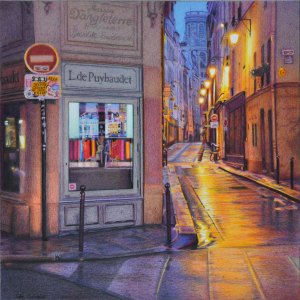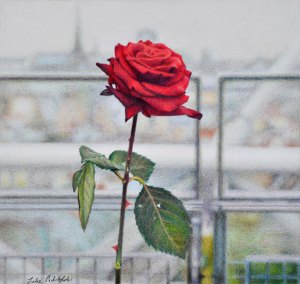
In 2010 it occurred to me that Kyoto might be the Paris of Japan. In fact it was my drawing “Confection” which gave me the thought. It has a sort of Belle Époque feel to it.

Even before “Confection” the drawing “Illuminating Dusk” made me reflect on Paris. I can’t quite say why it had this effect. Something about the architecture?
As I mulled over these ideas, it never crossed my mind that I would be going to Paris in late 2010 for a month!
Two of our three daughters were going to be in Paris for Christmas. My husband and I simultaneously thought ‘let’s join them’. We set off for our first European winter experience with our youngest daughter. Our whole family would be together in Paris!
One month prior to that trip I was visiting Kyoto. Across the street from my hotel there was an exhibition of Parisian photos by famous French Photograher, Willy Ronis. Wandering in awe around the exhibition I could not help but think ‘It’s a sign’.
Certainly I hoped that I would find inspiration in Paris as I was looking for a new subject after studying and drawing Kyoto for several years.

With my eyes wide open and my camera ever-ready I made the most of my time in Paris. Using the minimum of public transport and the maximum of leg power I explored at every opportunity. I got up before dawn plus I made sure I was out during dusk to get maximum opportunities from the transitory light conditions. It was absolutely freezing but I was hooked.

Back home, the Paris drawings poured forth. I was anxious that I might not be able to keep up the immediacy of feeling; that the Paris experience would fade and I would lose focus. Fortunately that did not happen. I had enough material to keep drawing for 16 months until the next trip; April 2012. The culmination of 20 months of drawing was my solo exhibition “Paris en hiver” in September 2012 in Perth.

Recently I was telling an artist friend that all my drawings are of other cities, as opposed to the city where I live. I said that while I am drawing, I am once again in those places, breathing the air whilst recreating the atmosphere and experience. He suggested that the drawing process therefore serves as a portal. Yes, I think he is right.

Working on subject matter which is a mix of the foreign and familiar (after all, I was there) makes an intoxicating and delicious cocktail. Each drawing satisfies but the thirst to do more remains unquenched.


After my “Paris en hiver” exhibition, I returned to Paris in October 2012 and April 2013 for more exploration, photography and simple inhalation of that city.

January 2016: In turn, my Paris drawings are influencing the way I am drawing Kyoto. Hence, Kyoto to Paris – and – Paris to Kyoto.

2016.

250 x 305 mm
December 2016: When I finished my 2016 art exhibition, “Fascination: Maiko, Geiko, Kyoto” – totally Kyoto subject matter – I returned to Paris for two weeks of photography. Now I am using those photos to do a new body of Paris drawings. What goes around, comes around: Kyoto-Paris-Kyoto-Paris.

January 2017

December 2016

April 2017

August 2017

November 2017

Have a look at my complete Kyoto and Paris collections on my website https://juliepodstolski.com/
Related posts: Quiet Voici Paris

I am interested in your comment above that each drawing satisfies, but the thirst to do more remains. Have you any idea what underpins this drive ? It seems to me to be a key (if not essential) characteristic of all true artists. I once asked an enamellist I know how she could part with the incredible pieces of enamelled jewellery she produced. Her response was that for her, at a certain point in the work currently being done, it became the next piece that mattered. What is it about doing the work that is so compelling for you ? I have to confess that I can’t think of a single activity I do that would warrant a similar comment.
You might notice that I make reference to “true” artists. I often wonder what the definition of an ‘artist’ is. Is it enough that it simply be someone who enjoys making marks on some kind of objects or is it more ? what would define a person as a ‘true’ artist as opposed to an amateur “puddler” ? I don’t know if you have any thoughts on these issues, but if you have I’d love to read them.
best wishes
Malcolm
ps. On another tack I have, at your suggestion read Ittens book (it took two readings and lots of notes but it was enjoyable) and am about to tackle some of the exercises. There is a problem however because his exercises are based on the primary colours of his colour circle. Is there any way of knowing which colours within the coloured pencil range most accurately approximate the primaries ?
Hello Malcolm,
Once again I am mulling over your questions. I don’t have an intelligent answer for your first question; except to compare the joy of drawing with the joy of ANYTHING ie gardening, cooking, playing sport… I suppose each person is wired a particular way and my way happens to be art. I like observing things in life – which is why I like travel. Seeing new places is so stimulating for the eyes. And I get deeply moved by some things I see – they evoke a strong emotional response. Quite often I want to recreate those things on paper. I experience the joy of reliving that experience while I’m doing the work and then the joy of having the finished product on the wall. So, gushing as it might sound, I have to admit that it is all a labour of love – expressing love of life. A gushing but true answer nevertheless.
I expect every artist IS an artist for a different reason. I can only speak for myself.
Guess what? I’ve found another colour theory book which might suit your needs more than Itten’s book. I found it in Europe but I’m sure it can be found on line. It is by David Hornung and is called “Colour: A workshop for artists and designers” I have the second edition, Laurence King Publishing ISBN: 978-1-85669-877-1 copyright 2005, 2012.
It suggests that you really need co-primaries – these consist of warm and cool versions of red, yellow and blue – because – just as you say – what is the most pure primary colour? Does the perfect primary yellow veer towards green or orange? And same with red and blue. ie rather than working with three colours which is limiting – you choose a warm and a cool version so work with six – plus white.
HI Julie
Thanks for comment and the reference, I will look it up. I have a copy of Albers book “interaction of colour” coming soon.
best wishes
Malcolm
The blurb in the book I’m writing to you about says that it makes an excellent companion to the Albers and the Itten. Fantastic!
So wonderful. I luv your work.
So nice of you to say so, Julie. Thank you.